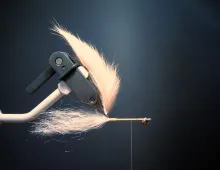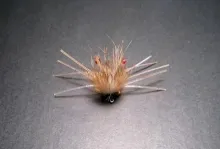This rabbit zonker fly imitates a mantis shrimp, a very important food resource for big permit and bonefish, and utilizes the mobile zonker strips to induce life in the fly.
History
I made this fly with the idea to imitate a mantis shrimp a very important food resource for big permit and bonefish.
The idea was to make a simple fly with few materials, but durable and full of life under water. The answer was the Zonker strip, a spectacular natural material, which looks full of life underwater, takes an almost translucent appearance and reacts to a minimum water current to make it look alive and entice the fish to strike the fly.
It is a must when you are looking for big permit and bonefish, but also works on other species like striped bass, redfish, corvina and any other shrimp eating species. It's a good step towards successful fishing to match the color of the fly with the bottom of the local environment.
Where to use this fly? At any location - especially in the tropics - where the mantis shrimp are abundant.
How to fish this fly? A good way it is making a few short fast strips and a pause. You can do some long and slow retrieves followed by short and fast strips.
Step 1
Place the dumbbell eyes near the front of the hook with figure-eight wraps. Cinch the wraps down to the hook shank by wrapping the thread parallel to the shank at the base of the eyes. This pulls the thread even tighter and helps keep the eyes from spinning. Apply a little of Clear Cure Goo Hydro or super glue to secure them in place.
Step 2
For the tail wrap the thread to the back of the hook shank , then Take a bunch of Slinky Fibers and tie them using the folding method to obtain more volume with less material. At first make just a few loose wraps and push the fibers using the forefinger and thumb together. Pinch the butt ends top to bottom and then side to side to equally distribute the fibers 360 degrees around the hook shank. Take some tight wraps to secure them. Fold back the rest of the fibers and make a few tight wraps and then use Clear Cure Goo Hydro or super glue to secure them in place. Trim the fibers to obtain the desired length and profile. The fibers' length has to be the same as the zonker strip, in this case almost 2 inches.
I recommend using a cardboard cutter blade to give a natural shape. Don't trim the fibers with a straight cut or the fly will look to unnatural.
Step 3
For the upper tail take a 2 inches zonker piece. With hook point riding up poke a hole in the hide where the zonker is penetrated by the hook point. Place zonker over the hook point and lay the strip against the hook shank. Make a few tight wraps to secure it.
|
|
|
|
Step 4
To create the legs take two strands of centipede legs and place one strand on each side. Tie them folded in half, then take six straws of Krystal flash folded in half on each side of the fly. With this technique we will get 12 strands of Krystal flash per side to create an attractive flashy profile.
Step 5
To add the eyes tie them in on the side of the hook shank. To obtain the right length, keep almost half inch from the hook gap to the eyes. Make tight wraps to secure them in place then pull them forward to create a V shaped appearance.
Step 6-7
For the body take a crosscut zonker strip and secure it just behind the eyes and start wrapping the zonker strip. Make tight and neat wraps to just behind the dumbbell eyes. Take the thread and make a few tight wraps to secure it and whip-finish. Apply Clear Cure Goo Tack Free to finish the fly.
- Log in to post comments



















Very similar to a st
Very similar to a stillwater pattern in the uk, 'The Bouncing Bomb' designed by a guy called Ben Bangham.
Hi Kate thanks for y
Hi Kate thanks for your kind words zonker it's an amazing materials my favorite natural by far, gives life to any fly.
All the best
Pedro
This really looks li
This really looks like a good mantis shrimp imitator. You have used the difficult to tie zonker strip in a very effective way.
Good luck when using this fly.
If I was a permit or a bonefish
Pedro,
If I was a permit or a bonefish this fly would certainly draw my attention, it does mimic a mantis shrimp. You have used
a normally bulky material in a very effective way. Good job.